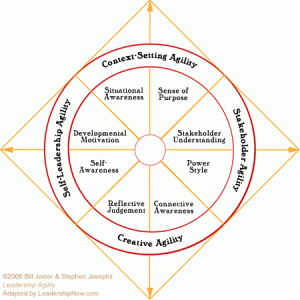By Rose O. Sherman, EdD, RN, FAAN
In a research study that I recently completed with a large sample of charge nurses, they reported that the pace of change in their work environments in response to shifting health policy is exhausting. Managing the change is also one of their most significant leadership challenges. Few leaders in health care today would argue with their assessment. Kirk Lawrence the Director of University of North Carolina Executive Development describes this as the “new normal”. The volatility, uncertainty, complexity and ambiguity in most work environments calls for a new set of leadership skills. Nurse leaders must be more agile in their ability to communicate change to staff and move quickly to apply new solutions when there is a sense of urgency.
Building Leadership Agility
Leadership agility has been described as acting with purpose and flexibility, collaborating with disparate stakeholders, developing creative solutions to complex problems, continually learning and changing. For many nurse leaders, this is a skill set that they may not currently have and need to build. In their book, Leadership Agility, authors Bill Joiner and Stephen Josephs outline 4 agility competencies as presented in the diagram below.
Context-setting agility is your ability to scan your environment, frame the initiatives you need to take, and clarify the outcomes you need to achieve. It entails stepping back and determining the best initiatives to take, given the changes taking place in your larger environment. It also involves how you frame the context of the environment for your staff. You will need to consider how recent changes in health policy might impact your environment? What do the new 30 day readmission penalties mean for your unit? What might you need to do differently as a staff to improve patient continuity on your unit?
Stakeholder agility is your ability to engage with key stakeholders in ways that build support for your initiative. It requires you to step back from your own views and objectives to consider the needs and perspectives of those who have a stake in your initiatives. If you are involved in an initiative to implement CPOE in your department (Computerized Physician Order Entry), what are the perspectives of the physicians who will be using the new system? What are their training needs? What are the advantages in the new system that will be of benefit to them in their practice?
Creative agility enables you to transform the problems you encounter into the results you need. It involves stepping back from your habitual assumptions and developing optimal solutions to the often novel and complex issues you face. As an example if your staffing is reduced because of budget cuts, what nursing activities or sacred cows could or should be eliminated. Could you streamline your documentation system? Try to think completely out of the box as you look at new solutions.
Self-leadership agility is the ability to use your initiatives as opportunities to develop into the kind of leader you want to be. It entails stepping back; becoming more aware of your thoughts, feelings, and behaviors; and experimenting with new and more effective approaches. This is an important competency because leaders often don’t reflect on aspects of their approaches that may no longer be effective. I recently spoke with a critical care manager who told me that her unit had a high turnover of Generation Y nurses. Upon reflection, she realized that she herself was a big part of the problem. She had great difficulty flexing her management style to accommodate different generational needs. She took the time to become aware of her feelings, educate herself on generational literature and change her approach.
The best nurse leaders are the best continuing learners. Developing leadership agility skills is a journey but one that will make you much more effective today and better able to manage future challenges.
Read to Lead
Joiner, B & and Josephs, S. (2007). Leadership Agility. San Francisco: John Wiley & Son.
Lawrence, K. (2013). Developing Leaders in a VUCA Environment. Whitepaper from the UNC Kenan-Flagler Business School.
© emergingrnleader.com 2013




 LinkedIn
LinkedIn Instagram
Instagram